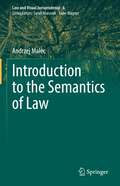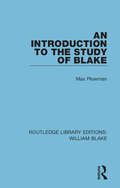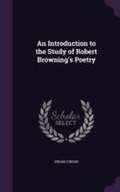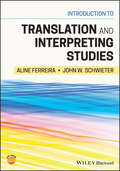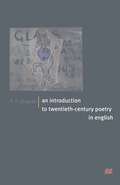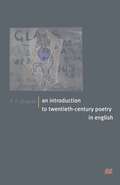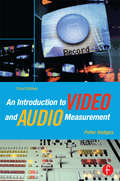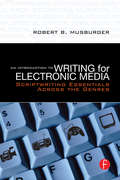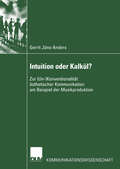- Table View
- List View
An Introduction to the Science of Deception and Lie Detection
by Chris N. StreetThis accessible book provides a foundational understanding of the science of deception and lie detection. Focusing on core issues for the field, it discusses classic and current psychological research into lying as well as theoretical approaches to understanding human lie detection. This book explores engaging questions around how people lie, how people make decisions about believing others, and how we can detect deception. Each chapter is clearly structured to support students of all levels by summarising content, presenting key research, and systematically evaluating findings. Chapters explore topics including some of the most promising current lie detection techniques, how and why people lie, how lying develops in children, and whether unconscious thinking can boost lie detection accuracy. Providing an overview of key issues in deception, this book will be of great interest to students and lecturers in the field of deception and lie detection, as well as anyone generally interested in this fascinating field of research.
An Introduction to the Science of Deception and Lie Detection
by Chris N. StreetThis accessible book provides a foundational understanding of the science of deception and lie detection. Focusing on core issues for the field, it discusses classic and current psychological research into lying as well as theoretical approaches to understanding human lie detection. This book explores engaging questions around how people lie, how people make decisions about believing others, and how we can detect deception. Each chapter is clearly structured to support students of all levels by summarising content, presenting key research, and systematically evaluating findings. Chapters explore topics including some of the most promising current lie detection techniques, how and why people lie, how lying develops in children, and whether unconscious thinking can boost lie detection accuracy. Providing an overview of key issues in deception, this book will be of great interest to students and lecturers in the field of deception and lie detection, as well as anyone generally interested in this fascinating field of research.
An Introduction to the Science of Phonetics
by Nigel Hewlett Janet Mackenzie BeckThe book is designed as an introduction to the scientific study of speech. No prior knowledge of phonetics is assumed. As far as mathematical knowlege is concerned, all that is assumed is a knowledge of simple arithmetic and as far as possible concepts are dealt with on an intuitive rather than mathematical level. The anatomical material is all fully explained and illustrated. The book is arranged in four parts. Part 1, Basic Principles, provides an introduction to established phonetic theory and to the principles of phonetic analysis and description, including phonetic transcription. Part 2, Acoustic Phonetics, considers the physical nature of speech sounds as they pass through the air between speaker and hearer. It includes sections on temporal measurement, fundamental frequency, spectra and spectrograms. Part 3, Auditory Phonetics, covers the anatomy of the ear and the perception of loudness, pitch and quality. The final part, Part 4, covers the articulatory production of speech, and shows how experimental techniques and tools can enhance our understanding of the complexities of speech production. Though the audience for this book is mainly students and professors in the Speech Sciences, it will also be valuable to any students studying hearing science and acoustics. The book is well supported with figures, tables, and practice boxes with experiments.
An Introduction to the Science of Phonetics
by Nigel Hewlett Janet Mackenzie BeckThe book is designed as an introduction to the scientific study of speech. No prior knowledge of phonetics is assumed. As far as mathematical knowlege is concerned, all that is assumed is a knowledge of simple arithmetic and as far as possible concepts are dealt with on an intuitive rather than mathematical level. The anatomical material is all fully explained and illustrated. The book is arranged in four parts. Part 1, Basic Principles, provides an introduction to established phonetic theory and to the principles of phonetic analysis and description, including phonetic transcription. Part 2, Acoustic Phonetics, considers the physical nature of speech sounds as they pass through the air between speaker and hearer. It includes sections on temporal measurement, fundamental frequency, spectra and spectrograms. Part 3, Auditory Phonetics, covers the anatomy of the ear and the perception of loudness, pitch and quality. The final part, Part 4, covers the articulatory production of speech, and shows how experimental techniques and tools can enhance our understanding of the complexities of speech production. Though the audience for this book is mainly students and professors in the Speech Sciences, it will also be valuable to any students studying hearing science and acoustics. The book is well supported with figures, tables, and practice boxes with experiments.
Introduction to the Semantics of Law (Law and Visual Jurisprudence #6)
by Andrzej MalecThis book offers an introduction to the language of law from the perspective of logical semantics. As a logical tool, Boguslaw Wolniewicz’s formal ontology of situations is adapted. The central issue addressed is the meaning of normative statements, primarily legal norms. The main outcome of the book consists in explications of several legal notions (including legal events, legal acts and legal rules) in terms of the formal ontology of situations. In addition, the book concludes that legal norms are sentences in a logical sense, so some are true, while others are false, and that their logical value does not depend on whether or not they were adopted in the law-making process. Lastly, the book contends that there are semantic relations between orders that are similar to entailment, contradiction, opposition, and sub-opposition, despite the fact that orders are not sentences in a logical sense, i.e., they are neither true nor false.The book also presents some original Wittgenstein-style deontic logics built on the first order logic. The formal results are applied to selected problems in the theory of law, including the problem of the possibility of algorithmic application of legal norms.
An Introduction to the Study of Blake (Routledge Library Editions: William Blake)
by Max PlowmanFirst published in 1927 (this edition in 1967), this book is about Blake, his symbols, and their meanings. As Ward says in his forward, the volume goes beyond Blake, becoming universal and timeless, and is about Religion. Plowman’s book presents itself, not as a critical text, but an interpretative one, and the study therefore illuminates the work of the author, as well as that of William Blake.
An Introduction to the Study of Blake (Routledge Library Editions: William Blake #5)
by Max PlowmanFirst published in 1927 (this edition in 1967), this book is about Blake, his symbols, and their meanings. As Ward says in his forward, the volume goes beyond Blake, becoming universal and timeless, and is about Religion. Plowman’s book presents itself, not as a critical text, but an interpretative one, and the study therefore illuminates the work of the author, as well as that of William Blake.
An Introduction to Transformational Syntax (Routledge Library Editions: Syntax #9)
by Roger FowlerTransformational syntax is an analytic technique of grammatical description which has exciting psychological and philosophical ramifications inspiring creative research into the conceptual powers and behaviour of man. In this book, first published in 1971, the author suggests that the techniques of the classical period (1964-66) of transformational syntax provide the securest foundation for syntactic analysis, and are indispensable if students are to understand recent changes to the analytical technique. This title will be of interest to students of language and linguistics.
An Introduction to Transformational Syntax (Routledge Library Editions: Syntax)
by Roger FowlerTransformational syntax is an analytic technique of grammatical description which has exciting psychological and philosophical ramifications inspiring creative research into the conceptual powers and behaviour of man. In this book, first published in 1971, the author suggests that the techniques of the classical period (1964-66) of transformational syntax provide the securest foundation for syntactic analysis, and are indispensable if students are to understand recent changes to the analytical technique. This title will be of interest to students of language and linguistics.
Introduction to Translation and Interpreting Studies
by Aline Ferreira John W. SchwieterA unique and balanced combination of translation and interpreting studies, edited and written by leading voices in the fields In Introduction to Translation and Interpreting Studies, accomplished scholars Aline Ferreira and John W. Schwieter have brought together a detailed and comprehensive introductory-level textbook covering the essential aspects of translation and interpreting studies. Through chapters authored by leading voices in the field, this book covers topics of theoretical and conceptual relevance—such as the history of the development of the field and methods for understanding gender, society, and culture as aspects of the role of the interpreter—as well as critical topics in the application of theory to real world practice. Beginning with an authoritative treatment of the theoretical developments that have defined the field since the early 1970s, this textbook first describes the influential work of such figures as Jakobson, Holmes, and Toury, thus ensuring students develop a thorough understanding of the history and theoretical underpinnings of the fields of translation and interpreting studies. The text then begins to introduce grounded discussions of interpreting in specialized fields such as legal and healthcare interpreting and sign language translation. Learning is reinforced throughout the text through pedagogical features including reflection questions, highlighted key words, further readings, and chapter objectives. Instructors will also have access to companion website with PowerPoint slides and multiple-choice questions to support classroom application. Truly a unique work in translation and interpreting studies, this essential new textbook offers: A thorough introduction to the fields of translation and interpreting with discussion of applications to interdisciplinary topics Explorations of translation machines and technology, including their history and recent trends Practical discussions of culture, gender, and society in the context of translation and interpreting studies, as well as training and pedagogical issues in translation and interpreting A concise examination of translation process research and methods, including the mental processes and actions that people take while translating Complementary web materials including PowerPoint slides and practice questionsIdeal for advanced undergraduate and graduate students in programs in such as linguistics, language studies, and communications, or for those who plan to work in translation and/or interpreting, Introduction to Translation and Interpreting Studies will earn a place in the libraries of anyone interested in a reader-friendly translation and interpreting resource.
Introduction to Translation and Interpreting Studies
by John W. Schwieter Aline FerreiraA unique and balanced combination of translation and interpreting studies, edited and written by leading voices in the fields In Introduction to Translation and Interpreting Studies, accomplished scholars Aline Ferreira and John W. Schwieter have brought together a detailed and comprehensive introductory-level textbook covering the essential aspects of translation and interpreting studies. Through chapters authored by leading voices in the field, this book covers topics of theoretical and conceptual relevance—such as the history of the development of the field and methods for understanding gender, society, and culture as aspects of the role of the interpreter—as well as critical topics in the application of theory to real world practice. Beginning with an authoritative treatment of the theoretical developments that have defined the field since the early 1970s, this textbook first describes the influential work of such figures as Jakobson, Holmes, and Toury, thus ensuring students develop a thorough understanding of the history and theoretical underpinnings of the fields of translation and interpreting studies. The text then begins to introduce grounded discussions of interpreting in specialized fields such as legal and healthcare interpreting and sign language translation. Learning is reinforced throughout the text through pedagogical features including reflection questions, highlighted key words, further readings, and chapter objectives. Instructors will also have access to companion website with PowerPoint slides and multiple-choice questions to support classroom application. Truly a unique work in translation and interpreting studies, this essential new textbook offers: A thorough introduction to the fields of translation and interpreting with discussion of applications to interdisciplinary topics Explorations of translation machines and technology, including their history and recent trends Practical discussions of culture, gender, and society in the context of translation and interpreting studies, as well as training and pedagogical issues in translation and interpreting A concise examination of translation process research and methods, including the mental processes and actions that people take while translating Complementary web materials including PowerPoint slides and practice questionsIdeal for advanced undergraduate and graduate students in programs in such as linguistics, language studies, and communications, or for those who plan to work in translation and/or interpreting, Introduction to Translation and Interpreting Studies will earn a place in the libraries of anyone interested in a reader-friendly translation and interpreting resource.
An Introduction to Twentieth-Century Czech Fiction: Comedies of Defiance
by Robert PorterA lucid and balanced appraisal of some of the best Czech fiction of the twentieth century.
An Introduction to Twentieth-Century Poetry in English
by R. P. DraperThis critical survey of modern poetry from Thomas Hardy to Seamus Heaney considers both the self-consciously revolutionary innovations of Modernism and more traditional developments, taking fully into account the extent to which 'English' can no longer be equated solely with England. Scots, Welsh and Irish poetry, and poetry from Commonwealth countries such as Australia, New Zealand and the Caribbean, are recognised as equally important aspects of the diversity that characterises modern poetry in English; and, in particular, the contributions of North American poets such as Ezra Pound, William Carlos Williams, Wallace Stevens and Robert Lowell receive the major emphasis that their achievement and extensive influence warrants and attention is given to important new perspectives in the work of women poets such as Adrienne Rich, Sylvia Plath and Elizabeth Bishop.
An Introduction to Twentieth-Century Poetry in English
by R.P. DraperThis critical survey of modern poetry from Thomas Hardy to Seamus Heaney considers both the self-consciously revolutionary innovations of Modernism and more traditional developments, taking fully into account the extent to which 'English' can no longer be equated solely with England. Scots, Welsh and Irish poetry, and poetry from Commonwealth countries such as Australia, New Zealand and the Caribbean, are recognised as equally important aspects of the diversity that characterises modern poetry in English; and, in particular, the contributions of North American poets such as Ezra Pound, William Carlos Williams, Wallace Stevens and Robert Lowell receive the major emphasis that their achievement and extensive influence warrants and attention is given to important new perspectives in the work of women poets such as Adrienne Rich, Sylvia Plath and Elizabeth Bishop.
An Introduction to Video and Audio Measurement
by Peter HodgesWhat do we measure and why? Peter Hodges explains the answer to this question in approachable language and with clear illustrations. Newcomers to the video industry, as well as those already established, will find this uniquely readable guide to the basics of a complex subject. Building on the success of the two previous editions of this popular title and covering both analog and digital video, the third edition includes new sections on audio measurement, high definition video, and innovative techniques of test and measurement.
An Introduction to Video and Audio Measurement
by Peter HodgesWhat do we measure and why? Peter Hodges explains the answer to this question in approachable language and with clear illustrations. Newcomers to the video industry, as well as those already established, will find this uniquely readable guide to the basics of a complex subject. Building on the success of the two previous editions of this popular title and covering both analog and digital video, the third edition includes new sections on audio measurement, high definition video, and innovative techniques of test and measurement.
An Introduction to Writing for Electronic Media: Scriptwriting Essentials Across the Genres
by Robert B. Musburger"Wonderfully practical....just what every media writer needs." Christopher H. SterlingGeorge Washington University* Learn what it takes to write for commercials, news, documentaries, corporate, educational, animation, games, the internet, and dramatic film & video productions * Outlines the key skills needed for a successful media writing career The demand for quality and knowledgeable multi-platform writing is always in high demand. An Introduction to Writing for Electronic Media presents a survey of the many types of electronic media you can write for, and explains how to do it. Musburger focuses on the skills you need to write for animation versus radio or television news versus corporate training. Sample scripts help you learn by example while modeling your own scripts. Production files illustrate the integral role writers' play in the production process, and individual movie frames allow you compare these to the real scripts. Armed with the skills developed in this book, a media writer can apply for a variety of positions in newsrooms, advertising firms, motion pictures or animation studios, as well as local and national cable operations. Robert B. Musburger, Ph.D., is Professor Emeritus and former Director of the School of Communication, University of Houston, USA. He has worked for 20 years in professional broadcasting, serving as camera operator, director, producer, and writer. Musburger has received numerous awards for his video work and teaching and he continues to work in electronic media with his Seattle, WA,. consulting firm, Musburger Media Services."[An] authoritative and clearly written description of the processes involved in writing for film, radio and television production."Raymond Fielding, Dean EmeritusFlorida State University
An Introduction to Writing for Electronic Media: Scriptwriting Essentials Across the Genres
by Robert B. Musburger"Wonderfully practical....just what every media writer needs." Christopher H. SterlingGeorge Washington University* Learn what it takes to write for commercials, news, documentaries, corporate, educational, animation, games, the internet, and dramatic film & video productions * Outlines the key skills needed for a successful media writing career The demand for quality and knowledgeable multi-platform writing is always in high demand. An Introduction to Writing for Electronic Media presents a survey of the many types of electronic media you can write for, and explains how to do it. Musburger focuses on the skills you need to write for animation versus radio or television news versus corporate training. Sample scripts help you learn by example while modeling your own scripts. Production files illustrate the integral role writers' play in the production process, and individual movie frames allow you compare these to the real scripts. Armed with the skills developed in this book, a media writer can apply for a variety of positions in newsrooms, advertising firms, motion pictures or animation studios, as well as local and national cable operations. Robert B. Musburger, Ph.D., is Professor Emeritus and former Director of the School of Communication, University of Houston, USA. He has worked for 20 years in professional broadcasting, serving as camera operator, director, producer, and writer. Musburger has received numerous awards for his video work and teaching and he continues to work in electronic media with his Seattle, WA,. consulting firm, Musburger Media Services."[An] authoritative and clearly written description of the processes involved in writing for film, radio and television production."Raymond Fielding, Dean EmeritusFlorida State University
Introductory Phonology (Blackwell Textbooks in Linguistics #32)
by Bruce HayesAccessible, succinct, and including numerous student-friendly features, this introductory textbook offers an exceptional foundation to the field for those who are coming to it for the first time. Provides an ideal first course book in phonology, written by a renowned phonologist Developed and tested in the classroom through years of experience and use Emphasizes analysis of phonological data, placing this in its scientific context, and explains the relevant methodology Guides students through the larger questions of what phonological patterns reveal about language Includes numerous course-friendly features, including multi-part exercises and annotated suggestions for further reading at the end of each chapter
Introductory Phonology (Blackwell Textbooks in Linguistics #36)
by Bruce HayesAccessible, succinct, and including numerous student-friendly features, this introductory textbook offers an exceptional foundation to the field for those who are coming to it for the first time. Provides an ideal first course book in phonology, written by a renowned phonologist Developed and tested in the classroom through years of experience and use Emphasizes analysis of phonological data, placing this in its scientific context, and explains the relevant methodology Guides students through the larger questions of what phonological patterns reveal about language Includes numerous course-friendly features, including multi-part exercises and annotated suggestions for further reading at the end of each chapter
The Introspective Art of Mark Twain
by Douglas AndersonThe Introspective Art of Mark Twain is a major new assessment of a towering American writer. Seeking to trace the development of Mark Twain's imagination, Douglas Anderson begins near the end of Twain's life, with the long dialogue What Is Man? that Twain published anonymously in 1906. In Twain's view, the little-read What Is Man? lies at the heart of his creative life. It is the central aesthetic testament that he employed to tell the story of his artistic evolution. Anderson follows the contours of that story as it unfolds over Twain's career. The portrait that emerges addresses the full scope of Twain's achievement, drawing on his autobiographical and travel writings, as well as the published and unpublished works of fiction that are by now deeply embedded in the world literary canon. "Steer by the river in your head,†? Mark Twain's master pilot, Horace Bixby, once advised him, when the opaque atmosphere of the outer world made it impossible to see the actual Mississippi through which Twain was trying to guide his steamboat. For the purposes of this book, the river in one's head is not a mental construct of the physical world but the riverine networks of consciousness itself: the river that is the mind. The detailed discussions of individual books that structure each chapter direct the attention of Mark Twain's students and admirers, through inward rather than outward channels, toward a fuller appreciation for his legacy.
The Introspective Art of Mark Twain
by Douglas AndersonThe Introspective Art of Mark Twain is a major new assessment of a towering American writer. Seeking to trace the development of Mark Twain's imagination, Douglas Anderson begins near the end of Twain's life, with the long dialogue What Is Man? that Twain published anonymously in 1906. In Twain's view, the little-read What Is Man? lies at the heart of his creative life. It is the central aesthetic testament that he employed to tell the story of his artistic evolution. Anderson follows the contours of that story as it unfolds over Twain's career. The portrait that emerges addresses the full scope of Twain's achievement, drawing on his autobiographical and travel writings, as well as the published and unpublished works of fiction that are by now deeply embedded in the world literary canon. “Steer by the river in your head,” Mark Twain's master pilot, Horace Bixby, once advised him, when the opaque atmosphere of the outer world made it impossible to see the actual Mississippi through which Twain was trying to guide his steamboat. For the purposes of this book, the river in one's head is not a mental construct of the physical world but the riverine networks of consciousness itself: the river that is the mind. The detailed discussions of individual books that structure each chapter direct the attention of Mark Twain's students and admirers, through inward rather than outward channels, toward a fuller appreciation for his legacy.
The Introverted Actor: Practical Approaches
by Rob Roznowski Carolyn Conover Heidi KasevichDo you have to be an extrovert to succeed as an actor? This book offers ideas to create inclusive acting environments where the strengths of the introverted actor are as valued as those of their extroverted counterparts. As this book shows, many introverts are innately drawn to the field of acting, but can often feel inferior to their extroverted peers. From the classroom to professional auditions, from rehearsals to networking events, introverted actors tell their stories to help other actors better understand how to leverage their natural gifts, both onstage and off. In addition, The Introverted Actor helps to reimagine professional and pedagogical approaches for both actor educators and directors by offering actionable advice from seasoned psychology experts, professional actors, and award-winning educators.
Intuition oder Kalkül?: Zur (Un-)Konventionalität ästhetischer Kommunikation am Beispiel der Musikproduktion (Kommunikationswissenschaft)
by Gerrit Jöns-AndersAus dem Blickwinkel einer interdisziplinär ausgerichteten Kommunikationswissenschaft untersucht Gerrit Jöns-Anders, inwieweit Intuition oder Kalkül handlungsrelevante Selektionskriterien für Komponisten darstellen. Es zeigt sich, dass Produzenten ästhetischer Medienangebote diese grundsätzlich im Wissen um Nutzererwartungen und damit auch im Wissen um Hoch- und Niedrigkonventionalität materialisieren und dass dies entscheidende Auswirkungen auf die klassischen Determinanten ästhetischer Theorien hat.



